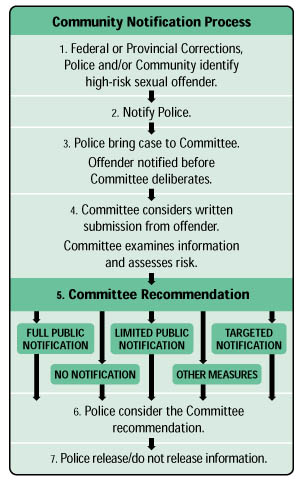Community Notification Advisory Committee (CNAC)
(Notifying the public about high risk sex offenders)
What does CNAC do?
The Community Notification Advisory Committee (CNAC) reviews cases of convicted sexual offenders thought to be at high risk to offend again and advises police about whether the public should be warned about such offenders living in the community. Manitoba was the first province in Canada to set up this type of program.
Who is on the Committee?
The committee is made up of people from the criminal justice and mental health systems who have the expertise to determine whether an offender is likely to commit further crimes. It has representatives from the RCMP, Winnipeg Police Service, Brandon Police Service, Manitoba Corrections, Correctional Service Canada and Manitoba Health. It also has a private citizen as a member to represent the interests of the general public.
How are offenders referred to the Committee?
When a police agency learns that a potentially dangerous convicted sexual offender is about to be released from jail, or is already living in the community, the situation is investigated to determine if the offender poses a threat to commit another sexual offence. If the police believe a threat exists, they refer the case to the committee for a recommendation about whether the public should be warned. Offenders are told that their case has been referred to the committee and that a public notification may be made. They are given an opportunity to make a written submission to the committee or get someone to do so on their behalf.
How does the Committee look at a case?
When the committee considers a case, it must decide what risk the offender poses, if the public should be warned and what type of warning should be made if it is needed. To reach those decisions, the committee carefully reviews all of the information they can about the offender, including:
- the offender's criminal record and psychological history;
- whether the offender has taken part in counselling or treatment programs;
- the age and sex of the offender's past victims;
- the offender's release plan or living arrangements; and
- what support and supervision services will be available for the offender.
- Submissions made by, or on behalf of, an offender.
Before deciding to name an offender publicly, the committee must also balance issues such as individual privacy rights, the risks that come with public alarm and what the effect on previous victims might be. The committee's discussions and deliberations are confidential.
What can the Committee do?
Once it has done a thorough review of the case, the committee can recommend one of the following measures:
- Full Public Notification: This is the strongest action the committee can recommend. It is a province-wide warning to all Manitobans, and includes a news release to the major media outlets. A photograph of the offender, a physical description of that person and the nature of their past offences may all be part of the public warning.
- Limited Public Notification: This is almost the same as a full public notification, except that the warning is limited to a specific community or group and the media outlets in the area.
- Targeted Notification: This is a warning that is limited to a specific community or group where there is no need to involve the media. This may be used for an offender who only targets victims of a certain age or sex or those who live in a remote, isolated community.
- No Notification: After reviewing the case, the committee may decide that the offender does not pose a high risk or that in the circumstances a warning or other action is not needed.
- Other Measures: The committee may recommend that police take other steps to ensure community safety, such as surveillance, applying for a court order to keep the offender from contacting children and other appropriate limitations.
What happens after a recommendation has been made?
Once the committee has made a decision on a case, the recommendation is sent to the police service that will handle it. The police agency is ultimately responsible for what action is or is not taken, including, notifying the offender. When it is possible and appropriate, the police notify the past victims before making a public notification.
What can you do when you see or hear a notification?
The purpose of public warnings is to give people the information they need to identify potential dangers to themselves and their families, develop safety plans and street-proof their children. THE WARNINGS ARE MADE ONLY SO THE PUBLIC MAY TAKE PROTECTIVE ACTION. THE POLICE WILL NOT TOLERATE ANY FORM OF VIGILANTE ACTIVITY OR OTHER UNREASONABLE CONDUCT DIRECTED AT AN OFFENDER. If you see the offender in public, you do not have to call the police unless they are committing a crime, harassing or threatening someone or behaving in a way that makes you think that there is a danger that they will commit a crime.
People notified about an offender should review their own safety status and practices. For example, it is always a good idea to stay away from poorly lit areas at night, ensure doors and windows are locked, and make sure someone knows if you are working late and when you should be home. Parents should ensure their children are aware of potentially dangerous situations, such as being offered a ride, candy or money or being asked to help find a lost pet. Children need to know what to do in these situations, and parents may want to review these safety precautions when a public alert has been made.
Requests for further information can be directed to:
Community Notification Advisory Committee
Telephone: (204) 945-3272
Fax: (204) 945-0433
CNAC is a joint initiative of the Province of Manitoba, RCMP, Winnipeg Police Service, Brandon Police Service and Correctional Service Canada.


